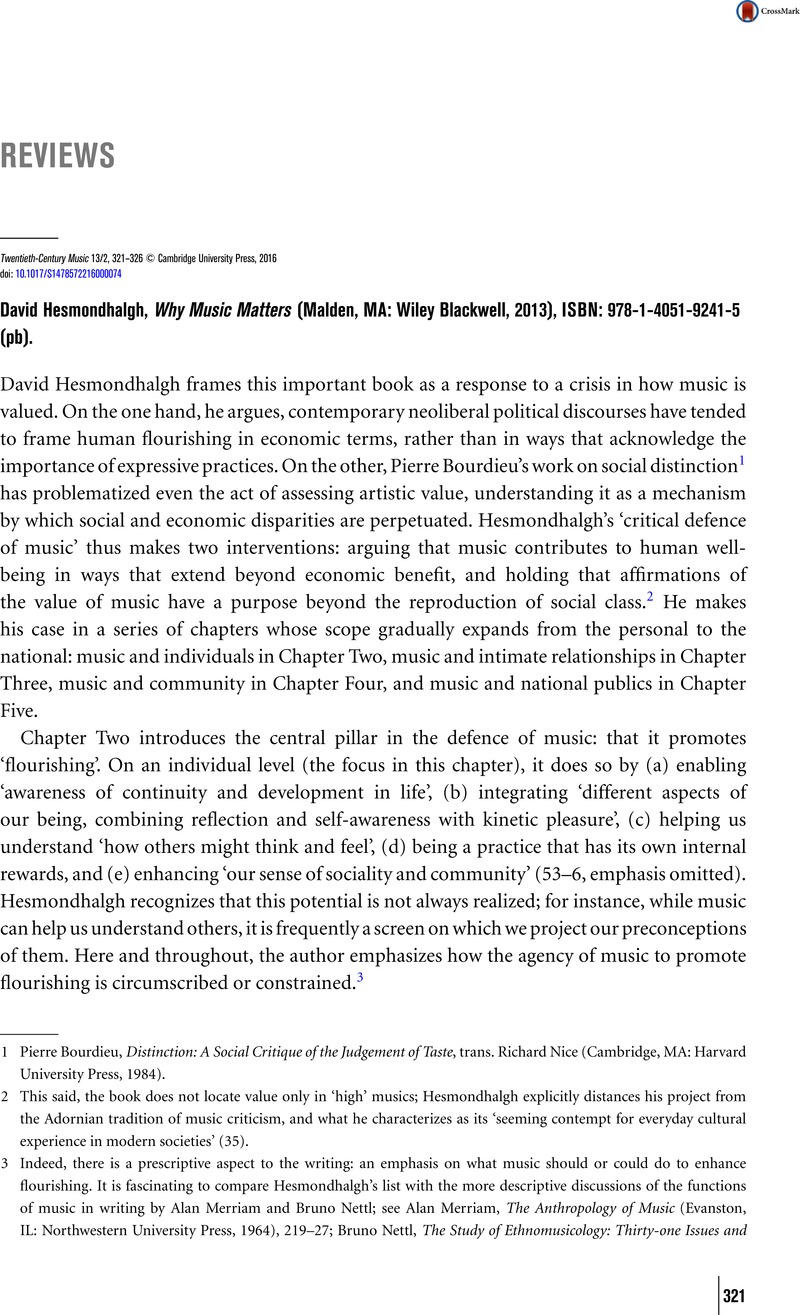No CrossRef data available.
Published online by Cambridge University Press: 16 August 2016

1 Bourdieu, Pierre, Distinction: A Social Critique of the Judgement of Taste, trans. Nice, Richard (Cambridge, MA: Harvard University Press, 1984)Google Scholar.
2 This said, the book does not locate value only in ‘high’ musics; Hesmondhalgh explicitly distances his project from the Adornian tradition of music criticism, and what he characterizes as its ‘seeming contempt for everyday cultural experience in modern societies’ (35).
3 Indeed, there is a prescriptive aspect to the writing: an emphasis on what music should or could do to enhance flourishing. It is fascinating to compare Hesmondhalgh's list with the more descriptive discussions of the functions of music in writing by Alan Merriam and Bruno Nettl; see Merriam, Alan, The Anthropology of Music (Evanston, IL: Northwestern University Press, 1964), 219–27Google Scholar; Nettl, Bruno, The Study of Ethnomusicology: Thirty-one Issues and Concepts, 2nd edn (Urbana, IL: University of Illinois Press, 2005), 244–58Google Scholar. Hesmondhalgh's goals are very different, yet all three authors might be said to be concerned with explaining ‘why music matters’.
4 See Keil, Charles, Urban Blues (Chicago: University of Chicago Press, 1966)Google Scholar; Keil, Charles and Keil, Angeliki V., Polka Happiness, photographs by Dick Blau (Philadelphia: Temple University Press, 1992)Google Scholar; or the discussion of karaoke in Turino, Thomas, Music as Social Life: The Politics of Participation (Chicago: University of Chicago Press, 2008), 49–51 Google Scholar.
5 See Turino, Thomas, ‘Signs of Imagination, Identity, and Experience: A Peircian Semiotic Theory for Music’, Ethnomusicology 43/2 (1999), 237–40CrossRefGoogle Scholar.
6 See Povinelli, Elizabeth, The Cunning of Recognition: Indigenous Alterities and the Making of Australian Multiculturalism (Durham, NC: Duke University Press, 2002)CrossRefGoogle Scholar; Povinelli, Elizabeth, ‘The State of Shame: Australian Multiculturalism and the Crisis of Indigenous Citizenship’, Critical Inquiry 24/2 (1998), 575–610 CrossRefGoogle Scholar. See also Michael Warner's critique of the idea of publicness as constituted through rational-critical discourse; Warner, Michael, Publics and Counterpublics (New York: Zone Books, 2002)Google Scholar.
7 Sen, Amartya, Development as Freedom (New York: Knopf, 1999)Google Scholar; Nussbaum, Martha C., Frontiers of Justice: Disability, Nationality, Species Membership (Cambridge, MA: Harvard University Press, 2006)Google Scholar.
8 For a critique of the framing of social and cultural difference as temporal distance, see Fabian, Johannes, Time and the Other: How Anthropology Makes Its Object (New York: Columbia University Press, 1983)Google Scholar.
9 See, for example, Gaunt, Kyra, The Games Black Girls Play: Learning the Ropes from Double-Dutch to Hip-Hop (New York: New York University Press, 2006)Google Scholar; Willett, Rebekah, Richards, Chris, Marsh, Jackie, Burn, Andrew, and Bishop, Julia C., eds, Children, Media and Playground Cultures: Ethnographic Studies of School Playtimes (New York: Palgrave Macmillan, 2013)CrossRefGoogle Scholar; Qureshi, Regula Burckhardt, Sufi Music of India and Pakistan: Sound, Context, and Meaning in Qawwali (Oxford: Oxford University Press, 1995)Google Scholar; or Butler, Melvin L., ‘Musical Style and Experience in a Brooklyn Pentecostal Church: An “Insider's” Perspective’, Current Musicology 70 (2000), 33–60 Google Scholar. The last of these demonstrates particular attention to the ways participatory music-making can exclude as well as include.